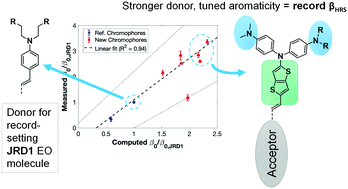Bis(4-dialkylaminophenyl)heteroarylamino donor chromophores exhibiting exceptional hyperpolarizabilities†
Abstract
Organic electro-optic (EO) materials incorporated into silicon-organic hybrid and plasmonic-organic hybrid devices have enabled new records in EO modulation performance. We report a new series of nonlinear optical chromophores engineered by theory-guided design, utilizing bis(4-dialkylaminophenyl)heteroarylamino donor moieties to greatly enhance molecular hyperpolarizabilities. Hyperpolarizabilities predicted using density functional theory were validated by hyper-Rayleigh scattering measurements, showing strong prediction/experiment agreement and >2-fold advancement in static hyperpolarizability over the best prior chromophores. Electric field poled thin films of these chromophores showed significantly enhanced EO coefficients (r33) and poling efficiencies (r33/Ep) at low chromophore concentrations compared with state-of-the-art chromophores such as JRD1. The highest performing blend, containing just 10 wt% of the novel chromophore BTP7, showed a 12-fold enhancement in poling efficiency per unit concentration vs.JRD1. Our results suggest that further improvement in chromophore hyperpolarizability is feasible without unacceptable tradeoffs with optical loss or stability.



 Please wait while we load your content...
Please wait while we load your content...